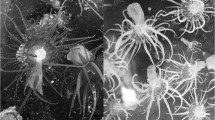Abstract
When symbiotic dinoflagellate algae (Symbiodinium sp.), isolated from the scleractinian coral Plesiastrea versipora were incubated in homogenized host tissue, carbon fixation was usually lower than in seawater only (43 cases of of 54), and this inhibition occurred throughout the year. Algae incubated in homogenized host tissue fixed a mean of 78.84% ± 22.6% of the amount fixed by algae in seawater (n = 54, range 33–142%). The difference between rates of fixation in seawater (mean ± SD of 61.300 ± 22.71 nmol C/105 cells) and in homogenates (mean ± SD of 47.377 ± 21.42 nmol C/105 cells) in individual experiments, was highly significant (p<0.0001, paired t-test). Homogenized host tissue from populations of P. versipora separated by 4000 km inhibited photosynthesis in algae from both their own and the distant coral population. Inhibition of photosynthesis was not observed when isolated algae from the anemone, Aiptasia pulchella were incubated in homogenate from P. versipora. An inhibitor of photosynthesis was isolated from a low molecular weight fraction of homogenized host tissue of P.versipora by cation-exchange chromatography and further purified by HPLC. This is the first natural inhibitor of photosynthesis that has been found in an invertebrate with symbiotic algae.
Similar content being viewed by others
REFERENCES
Gates, R. D., O. Hoegh-Guldberg, M. J. McFall-Ngai, K. Y. Bil' & L. Muscatine, 1995. Free amino acids exhibit anthozoan ‘host factor’ activity: They induce the release of photosynthate from symbiotic dinoflagellates in vitro. Proc. natn. Acad. Sci. U.S.A. 92: 7430–7434.
Grant, A. J., M. Rémond, J. People & R. Hinde, 1997. Effects of host tissue homogenate of the scleractinian coral Plesiastrea versipora on glycerol metabolism in isolated symbiotic dinoflagellates. Mar. Biol. 128: 665–670.
Grant, A. J., M. Rémond & R. Hinde, 1998. Low molecular-weight factor from Plesiastrea versipora (Scleractinia) that modifies release and glycerol metabolism of isolated symbiotic algae. Mar. Biol. 130: 553–557.
Hinde, R., 1988. Factors produced by symbiotic marine invertebrates which affect translocation between the symbionts. In Scannerini, S., D. Smith, P. Bonfante-Fasolo & V. Gianninazzi-Pearson (eds), Cell to Cell Signals in Plant, Animal and Microbial Symbiosis. Berlin & Heidelberg: Springer-Verlag: 311–324.
McAuley, P. J., 1981. Control of cell division of the intracellular Chlorella symbionts in green hydra. J. Cell Sci. 47: 197–206.
McAuley, P. J. & C. B. Cook, 1994. Effects of host feeding and dissolved ammonium on cell division and nitrogen status of zooxanthellae in the hydroid Myrionema amboinense. Mar. Biol. 121: 343–348.
Muscatine, L., 1967. Glycerol excretion by symbiotic algae from corals and Tridacna and its control by the host. Science 156: 516–519.
Muscatine, L., R. R. Pool & E. Cernichiari, 1972. Some factors influencing selective release of soluble organic material by zooxanthellae from reef corals. Mar. Biol. 13: 298–308.
Muscatine, L. & R. R. Pool, 1979. Regulation of numbers of intracellular algae. Proc. r. Soc. Lond. B 204: 131–139.
Ritchie, R. J., K. Eltringham & R. Hinde, 1993. Glycerol uptake by zooxanthellae of the temperate hard coral, Plesiastrea versipora (Lamarck). Proc. r. Soc. Lond. Ser. B 253: 189–195.
Rogerson, A., M. Polne-Fuller, R. K. Trench & A. Gibor, 1989. A laboratory-induced association between the marine amoeba Trichosphaerium AM-1-7 and the dinoflagellate Symbiodinium #8. Symbiosis 7: 229–241.
Smith, G. J. & L. Muscatine, 1999. Cell cycle of symbiotic dino-flagellates: Variation in G1 phase-duration with anemone nutritional status and macronutrient supply in the Aiptasia pulchella-Symbiodinium pulchrorum symbiosis. Mar. Biol. 134: 405–418.
Steen, R. G., 1987. Evidence for facultative heterotrophy in cultured zooxanthellae. Mar. Biol. 95: 15–23.
Sutton, D. C. & O. Hoegh-Guldberg, 1990. Host-zooxanthellae interactions in four temperate marine invertebrate symbioses: assessment of effect of host extracts on symbionts. Biol. Bull. 178: 175–186.
Trench, R. K., 1971. The physiology and biochemistry of zooxanthellae symbiotic with marine coelenterates. III. The effect of homogenates of host tissues on the excretion of photosynthetic products in vitro by zooxanthellae from two marine coelenterates. Proc. r. Soc. Lond. Ser. B 177: 251–264.
Wang, J-T. & A. E. Douglas, 1997. Nutrients, signals and photosynthate release by symbiotic algae: the impact of taurine on the dinoflagellate alga Symbiodinium from the sea anemone Aiptasia pulchella. J. Plant Physiol. 114: 631–636.
Withers, K. J. T., A. J. Grant & R. Hinde, 1998 Effects of free amino acids on the isolated symbiotic algae of the coral Plesiastrea versipora (Lamarck): absence of a host release factor response. Comp. Biochem. Physiol. Part A 120: 599–607.
Author information
Authors and Affiliations
Rights and permissions
About this article
Cite this article
Grant, A., Rémond, M., Withers, K. et al. Inhibition of algal photosynthesis by a symbiotic coral. Hydrobiologia 461, 63–69 (2001). https://doi.org/10.1023/A:1012777502179
Issue Date:
DOI: https://doi.org/10.1023/A:1012777502179




